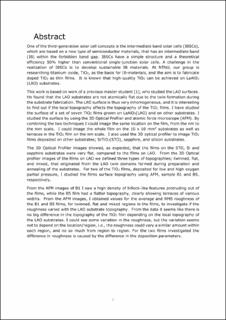| dc.description.abstract | One of the third-generation solar cell concepts is the intermediate band solar cells (IBSCs), which are based on a new type of semiconductor materials, that has an intermediate band (IB) within the forbidden band gap. IBSCs have a simple structure and a theoretical efficiency 50% higher than conventional single-junction solar cells. A challenge in the realization of IBSCs is to develop sustainable IB materials. At NTNU, our group is researching titanium oxide, TiO2, as the basis for IB-materials, and the aim is to fabricate doped TiO2 as thin films. It is known that high-quality TiO2 can be achieved on LaAlO3 (LAO) substrates.
This work is based on work of a previous master student [1], who studied the LAO surfaces. He found that the LAO substrates are not atomically flat due to the twin formation during the substrate fabrication. The LAO surface is thus very inhomogeneous, and it is interesting to find out if the local topography affects the topography of the TiO2 films. I have studied the surface of a set of seven TiO2 films grown on LaAlO3(LAO) and on other substrates. I studied the surface by using the 3D Optical Profiler and atomic force microscope (AFM). By combining the two techniques I could image the same location on the film, from the nm to the mm scale. I could image the whole film on the 10 x 10 mm2 substrates as well as terraces in the TiO2 film on the nm scale. I also used the 3D optical profiler to image TiO2 films deposited on other substrates; SrTiO3(STO), sapphire, and silicon substrates.
The 3D Optical Profiler images showed, as expected, that the films on the STO, Si and sapphire substrates were very flat, compared to the films on LAO. From the 3D Optical profiler images of the films on LAO we defined three types of topographies; twinned, flat, and mixed, that originated from the LAO twin domains formed during preparation and annealing of the substrates. For two of the TiO2 films, deposited for low and high oxygen partial pressure, I studied the films surface topography using AFM, sample B1 and B5, respectively.
From the AFM images of B1 I saw a high density of hillock-like features protruding out of the films, while the B5 film had a flatter topography, clearly showing terraces of various widths. From the AFM images, I obtained values for the average and rms roughness of the B1 and B5 films, for twinned, flat and mixed regions in the films, to investigate if the roughness varied with the LAO substrate topography. From the data it seems like there is no big difference in the topography of the TiO2 film depending on the local topography of the LAO substrates. I could see some variation in the roughness, but the variation seems not to depend on the location/region, i.e., the roughness could vary a similar amount within each region, and no so much from region to region. For the two films investigated the difference in roughness is caused by the difference in the deposition parameters. | |
